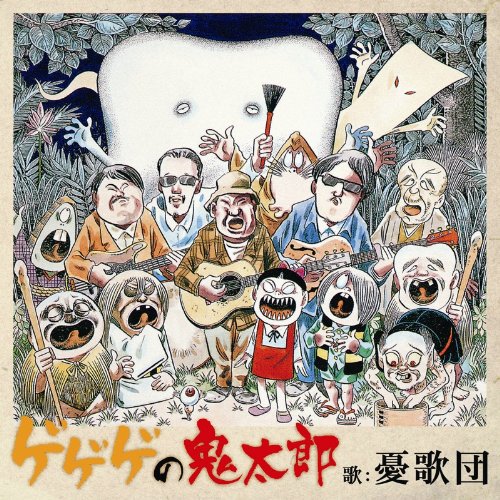
Mizuki Shigeru was born Mura Shigeru, on March 8th, 1922, in Japan’s tumultuous Showa era. He grew up in the relatively small town, Sakaiminato, in Tottori Prefecture, where he developed a reputation as a child for his artistic ability, as well as his scrappiness. Besides art, he was fascinated by the supernatural, specifically, the stories about Japanese ghosts, yokai, told to him by a local woman he nicknamed “NonNonBa.”
In 1942, when Japan was embroiled in World War II, he was drafted into the Imperial Japanese Army, and deployed to Papua New Guinea, in the Pacific Theater. On top of dealing with the horrors of war, he contracted a life-threatening case of malaria and was nursed back to health by the island’s locals. Before the war’s conclusion and Japan’s unconditional surrender, he was caught in an Allied Army air raid and lost his dominant left arm in an explosion. In the post-war occupation, the spirit of Japan changed, and Mizuki worked various jobs before breaking into the world of illustration as a cartoonist and manga artist.
Mizuki’s work was heavily influenced by his experiences during the war, the mentality of the Japanese people during the occupation, as well as his lifelong interest in yokai. He was a prolific writer and illustrator (especially considering he only had one arm!), who brought yokai back into popular consciousness and constantly advocated for pacifism. Before his death by heart attack in 2015, he was considered one of the most influential manga artists in Japan’s history. Here’s our list of the Top 5 Manga by Mizuki Shigeru!
5. Akuma-Kun

- Genre: Supernatural, Action, Adventure
- Volumes: 1
- Published Date: December 1965 – March 1967
Although there was an earlier iteration of Akuma-Kun published until 1963, and a later iteration published in the 1980s, it’s the version published through to 1967 that serves as our number 5 entry on the list! In the world of Akuma-Kun, it is said that every 10,000 years a child capable of using the hidden power contained within the Jewish scripture would arise, and be able to use that power to summon demons. The closest the world has come is the amazing Professor Faust, who has managed to live for 300 years in anticipation of the birth of the one who would succeed where he failed.
Enter Shingo Yamada. Considered a genius by all who know him, Shingo wishes to create a peaceful world where all can be equal. Toward that end, he attempts to solve the mystery regarding the power of the demons, so that he can use the power for good. Although determined and bright, his search for clues is fruitless, until he encounters Professor Faust. With Faust’s aid, he is able to resurrect a powerful demon named Mephisto, who he is able to control using the magical Solomon flute entrusted to him by Faust before his unfortunate death. With his success in summoning a demon to the world of man, he becomes the target of a group of powerful wizards, who wish to steal the Solomon flute and use its power for their own nefarious ends.
Unlike the previous run of the series, this version changed to deal less with outright horror, in the hopes of achieving a wider audience. Mizuki’s love of the supernatural can be seen in full-force here, as can his desire for world peace, as Mephisto and Shingo fight to save the day and create a better world. Although the art style isn’t as polished as some of Mizuki’s later works, it has the iconic artwork for which he came to be known and hinted at the artist and storyteller he was to become.
4. Onward Towards Our Noble Deaths (Souin Gyokusai seyo!)
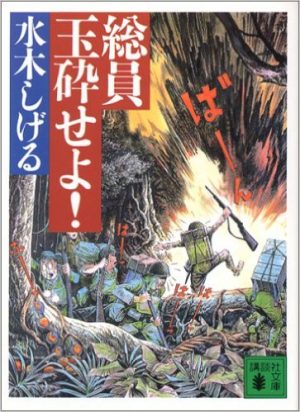
- Genre: Drama, Historical, Military
- Volumes: 1
- Published Date: August 1973
One of the first works to be translated and receive critical acclaim in the west, Onward Toward Our Noble Deaths won a prestigious Eisner Award after its publication in 2011. A fictionalized account of the time he spent deployed in the Pacific in World War II, Onward Toward Our Noble Deaths takes place in New Guinea in 1943. The story follows the soldiers stationed there as they prepare for an imminent Allied attack.
With hunger rampant due to limited rations, and the barracks riddled with both malaria and dengue fever, the stationed officers are on edge and troop morale is at a constant low. The talk amongst the ranks is in whispered fear of a banzai charge, or suicide attack, and not if the order will come down from their superiors, but when. The story is composed of a variety of vignettes that show the all-too-real horrors of war, where the almost inevitable prospect of death weighs heavily in the hearts of the almost indistinguishably tragic soldiers.
Although dramatized, the depiction of the joyless lives of the soldiers in the Imperial Army during World War II is realized with heartbreaking realism and serves as evidence for the tribulations endured by Mizuki during his time in the military. Characters are crudely depicted, but the battle scenes and environments are drawn with a level of meticulous care depict the real human cost of battle. Clearly not a read for the faint of heart, Onward Toward Our Noble Deaths is a grueling tale that begs a reader’s attention, and demands not to be forgotten.
3. NonNonBa (Nonnonba to Ore)
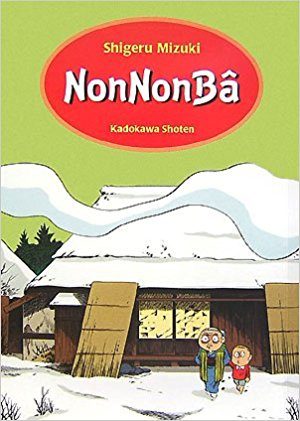
- Genre: Drama, Slice of Life, Supernatural
- Volumes: 2
- Published Date: August 1992 – October 1992
A lovingly-written autobiographical memoir about his childhood in Sakaiminato, NonNonBa focuses on Fusa Kageyama, the deeply spiritual old woman who acted as Mizuki’s mentor as he grew up, and provided the work with its namesake. A translated English version was published in 2012 to critical acclaim, increasing his presence in the western literary world.
NonNonBa is set in the 1930s, during the Showa era. At a time when Japan was embroiled in a literal war with its neighbors, and its citizens were caught in a war of identity as society rushed towards the future while struggling to maintain a connection with its past, Mizuki learned much about the physical world around him from NonNonBa. More importantly, he also learned about the unseen world of Japanese spirits, yokai; their names, which ones were good or bad, and how to avoid raising their ire. The book is divided into several chapters that detail his encounters with these supernatural forces and telegraph his deep connection with NonNonBa, and the lifelong influence yokai would have on him.
Besides serving as a veritable encyclopedia of the yokai, NonNonBa is also a deeply personal, emotionally resonant slice-of-life story. The feelings Mizuki had for his mentor permeate every page, and the sincerity of his narrative will make even the staunchest realist yearn to believe in a world where such colorful spirits enter the lives of humans on a daily basis.

2. GeGeGe no Kitaro

- Genre: Adventure, Supernatural, Comedy
- Volumes: 17
- Published Date: 1965 – 1986
A series so immense that it rocketed Mizuki Shigeru into the pantheon of manga legends, GeGeGe no Kitaro may not need an introduction. The series was an original creation of Mizuki’s that debuted first as a kamishibai, a type of Japanese storytelling with still images told in front of an audience. First known as Hakaba no Kitaro, or Kitaro of the Graveyard, the spook-factor was toned down and the overall cuteness of the illustrations was amped up, creating a character that is still loved in Japan today.
The story focuses on a “boy” named Kitaro, who is the last surviving member of the mysterious Ghost Tribe, and the adventures he has with supernatural beings from Japan and around the globe. He is a friendly boy who wants the best for mankind and yokai alike and often seeks the help of the remains of his father, Medama-Oyaji, and a cadre of benevolent spirits who help him further his cause. While some of the collected stories are adaptations of popular Japanese folktales, many are original tales that see Kitaro face off against mean-spirited supernatural beings from Japan and elsewhere who seek to dominate the yokai world and bring misery to humans.
GeGeGe no Kitaro may not have the edge that its earlier iterations did, but its characters and art style have an almost universal appeal that demonstrates how it became so beloved in the first place. In Japan and around the globe, Kitaro has provided many readers their first glimpse into the yokai world and is directly responsible for the popularity of other enduring otaku-friendly properties such as Yokai Watch. Kitaro’s adventure are an easy read suitable for any audience, making it a perfect family friendly introduction into Japanese storytelling.
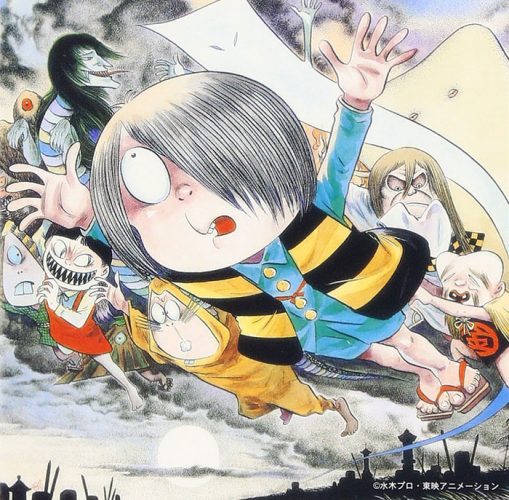
1. Showa: A History of Japan (Comic Showa-shi)

- Genre: Historical
- Volumes: 8
- Published Date: November 1988 – December 1989
A work that has won multiple awards in Japan and the U.S., Showa: A History of Japan is a semi-autobiographical work that details Mizuki Shigeru’s life through to adulthood, as well as a broader glimpse at the state of the world during Japan’s Showa era. It was adapted into four English volumes, the last of which was published in 2015, the same year that Mizuki passed away.
A combination of his other works, Showa borrows pieces from NonNonBa and Onward Toward Our Noble Deaths to tell a complete story of Mizuki’s impoverished, whimsical childhood, his aimless adolescence, his terrifying time spent in the Japanese Imperial Army, and the hardships as a civilian in Allied-occupied post-war Japan before “making it” as an artist. At the same time, through the use of his original character “Nezumi Otoko,” best known for his presence in Kitaro, he narrates the tumultuous real-life events that changed Japan and the rest of the world.
In Showa, Mizuki pulls no punches, refusing to shy away from the difficult subjects and events that led to such large-scale suffering around the globe. The amount of time and care that went into researching the events that helped shape the course of Japan and countries around the globe is evident throughout the series and accompanied by a well-organized glossary of terms. While the broader, sweeping tale of the tides of change will appeal to history buffs, the deeply personal story at the heart of the narrative offers readers a glimpse into the heart of a man who helped shape the manga industry, and shouldn’t be missed.
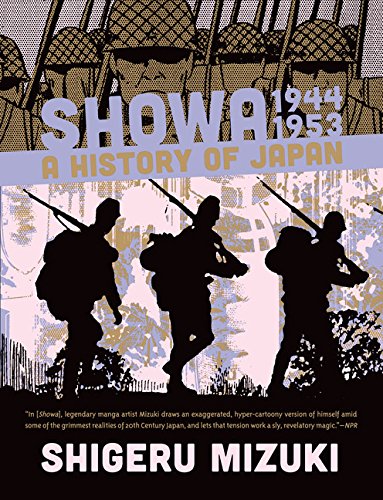
Final Thoughts
With that, our list of the Top 5 Manga by Mizuki Shigeru comes to a close. Although his body of work isn’t as prolific as some other writers in the industry, his influence on the industry and Japan as a whole is undeniable. What ways has Mizuki helped shape your perception of Japan? Has he set you on the lookout for yokai? Are there works that weren’t covered in the list that readers would regret missing out on? Sound off in the comments section and let us know!

